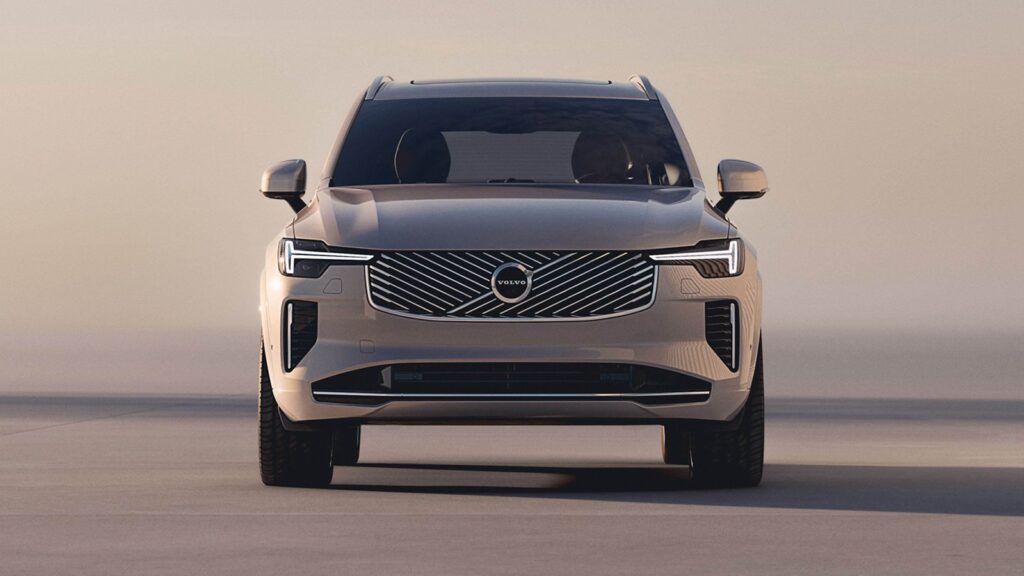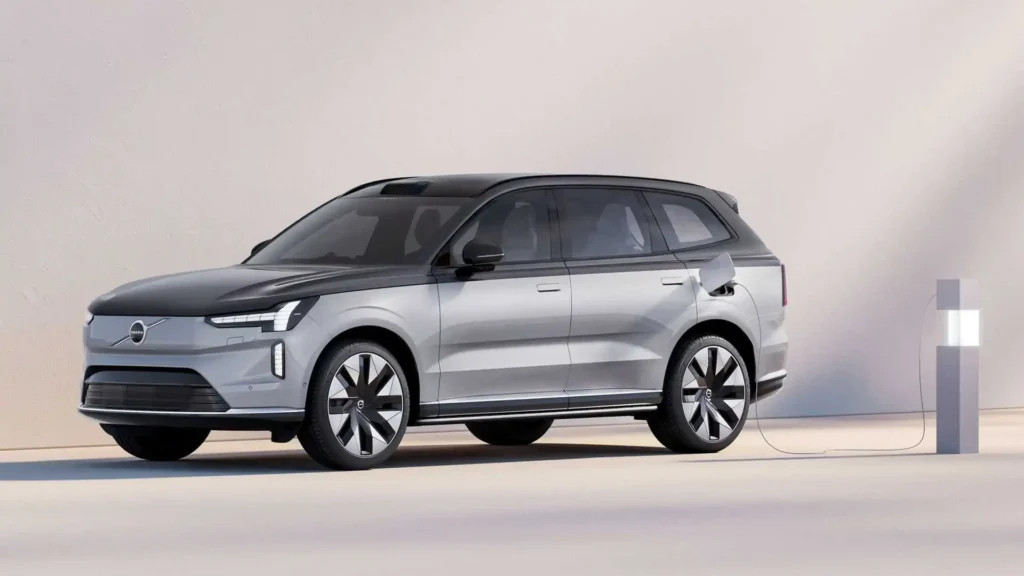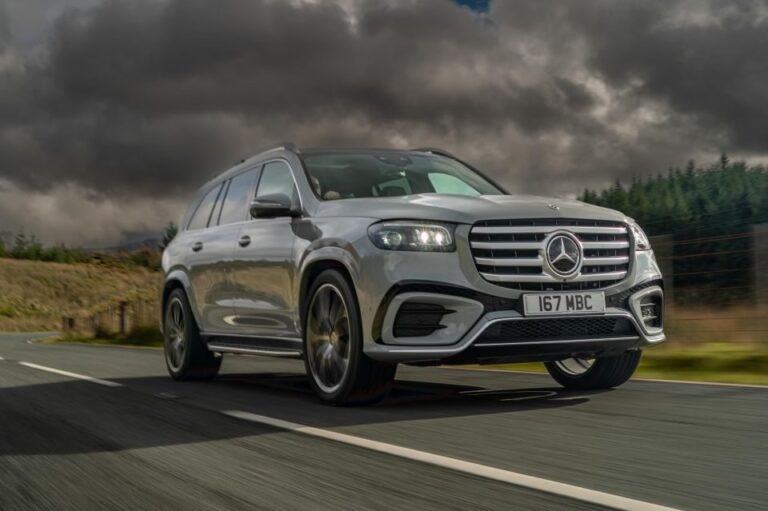Volvo has continued its shift to an all-electric lineup with the launch of the EX90, a new flagship SUV. It sits above the gasoline-powered XC90 and has a sleeker appearance than the XC90 while keeping the iconic Volvo style cues like the vertically oriented taillights and “Thor’s Hammer” LED headlamps. There will be a base 402-hp electric powertrain that should be more than sufficient for rapid acceleration; a 510-hp Performance version is also offered. The EX90 can go 300–310 miles on a single charge thanks to its enormous battery pack, and it can be recharged quickly via a DC fast-charging connector. Additionally, the EX90 displays the company’s cutting-edge driver assistance technologies, such as a new driver monitoring system that can intervene on behalf of the driver if it notices discomfort or diversion.

Exterior Design
The XC90’s wheelbase is the same as the EX90’s predecessor. Nonetheless, it’s clearly longer, which gives more inside space and storage room with a front trunk or “frunk” and a big boot. From a design point of view, there are the well-known “Thor’s Hammer” headlights, which have been very advanced with indicators in sophisticated LED technology. The whole front is sealed, with active louvres at its base that open or close as a function of the cooling requirements of the vehicle. All such design elements lead to a coefficient of drag of 0.29 for the EX90.
An external LiDAR system is also included in the exterior. The said advanced sensor technology is included as standard in the EX90, and it contributes to the semi-autonomous driving capability of the car, but full functionality of the said feature may not be offered for some markets. Available globally in 4, 5, 6, and 7-seater models but being introduced Down Under in 7-seater form.
Range, Charging, and Battery Life
The EX90 has a 111 kWh battery capacity that accommodates both AC and DC charging. It can charge at 3-phase 16 amps for AC charging and for DC charging up to 250 kW. Volvo claims a 570-km driving range on the WLTP cycle, stretching up to 640 km on the combined cycle – an impressive number for an electric SUV of this size.

The EX90 rides on a set of 22-inch alloy wheels with a sleek design optimized for aerodynamics. The general design is modern and smooth, integrating familiar elements of the current Volvo design with a futuristic approach. The dimensions are proportionate, adding to the modernity and elegance of the vehicle.
Interior
The EX90 is sheer class in terms of the interior; it’s minimalistic to the maximum. The automaker has done away with just about all of the buttons and controls, having most of the functions centralized around a huge infotainment screen and the steering wheel. Top-notch materials grace the interior, from textured wood trim to premium finishes. Another interesting feature is the gear selector, which used to be on the central console but now resembles Volkswagen’s.
The phone can also be used as a key, using either an NFC or an NFC card. Then there’s the wireless phone charging, complete with cooling vents to prevent overheating—especially when features like Apple CarPlay or Android Auto, which tend to heat up the phone, are put to use.
When it comes to comfort features, no detail has been ignored by Volvo: there are massage functions in the seats and a well-thought-out driver monitoring system. Important information is displayed on a small screen in front of the driver and is safeguarded through the LiDAR system, which monitors the attention level of the driver.
Infotainment and Connectivity Features
The EX90 has a big, portrait-style 14.5-inch infotainment display that runs the company’s latest Google-based infotainment system. It includes in-dash navigation provided by Google Maps and access to external apps via the Google Play store. Wireless Apple CarPlay and a 5G cellular data connection are also standard. A Bowers & Wilkins stereo system is offered as an option, including Dolby Atmos technology and 25 speakers, including those built in the EX90’s headrests.

Tech Features
The Volvo EX90 features an Android Automotive OS, the same as what Porsche has adapted for its new models. This operating system allows Volvo to build its own software stack on top of Android, which guarantees the seamless integration of Google Maps, voice recognition via Google Assistant, and other core functions. Easily operable, even for driving, the system is quite intuitive and buttonless in nature. However, the camera which engages while reversing is really poor in quality, grainy, really not up to the standards that you would expect for a modern vehicle.
Practicality and Storage
Regarding storage, the car can hold far too much, with a centre console, cup holders, and underfloor storage. The middle-row seats slide to offer more flexibility with seating, but the third row is best suited for children or smaller adults due to the limited legroom. Its cargo space with the third row folded is down at around 2,170 litres, dropping to 380 litres when the third row is in use.
The Driving Experience
The EX90 driving experience is achieved through air suspension that maintains ride quality even with larger 22-inch wheels. The vehicle weighs nearly 3 tons, yet it feels light and manoeuvrable. This sends some of the torque to the rear axle, which is also adjustable thanks to a dual-clutch setup, thus providing a kind of torque vectoring effect that will offer better handling, particularly in performance-oriented driving modes.
As for the power numbers, the top-spec model of the EX90 produces almost 400kW and over 900Nm of torque. This allows the vehicle to accelerate from 0 to 100 km/h in under five seconds, which is quite an achievement for a vehicle of this size and weight. The base version will be slightly less quick, completing the benchmark sprint in 0-100 km/h in closer to six seconds.
Its speed is limited to 180 km/h, which is consistent with Volvo’s safety ethos. The air suspension is optional but may become standard on a few models to ensure that your ride is smooth and adaptive.
Noise Insulation and Sound System
The cabin in the EX90 is very quiet—a given with electric vehicles—but Volvo has gone further to ensure silence in the cabin even at highway speeds. It is fitted with a class-leading Bowers & Wilkins sound system, boasting more than 20 speakers, each with its channel, which creates an immersive audio experience.
Autonomous Driving Features
An example is the LiDAR system and other sensors that enable the EX90 to have semi-autonomous driving capabilities, especially on highways. For example, lane-keeping and even changing are just a tap of the indicators away. It surely performs at its best on highways, though in suburban settings, it might feel less confident where it might not be much of use.
Pricing
In terms of pricing, The price of the 2025 Volvo EX90 starts at $81,290 and goes up to $87,340 depending on the trim and options.














